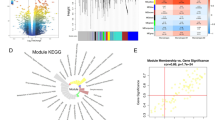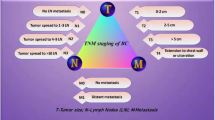Abstract
Activation of inflammatory pathways is one plausible mechanism underlying the association between obesity and increased breast cancer risk. However, macrophage infiltration and local biomarkers of inflammation in breast adipose tissue have seldom been studied in association with obesity. Gene expression profiles of normal breast tissue from reduction mammoplasty patients were evaluated by whole genome microarrays to identify patterns associated with obesity status (normal-weight, body mass index (BMI) <25; overweight, BMI 25–29.9; obese, BMI ≥30). The presence of macrophage-enriched inflammatory loci with immunopositivity for CD68 protein was evaluated by immunohistochemistry (IHC). After adjusting for confounding by age, 760 genes were differentially expressed (203 up and 557 down; FDR = 0.026) between normal-weight and obese women. Gene ontology analysis suggested significant enrichment for pathways involving IL-6, IL-8, CCR5 signaling in macrophages and RXRα and PPARα activation, consistent with a pro-inflammatory state and suggestive of macrophage infiltration. Gene set enrichment analysis also demonstrated that the genomic signatures of monocytes and macrophages were over-represented in the obese group with FDR of 0.08 and 0.13, respectively. Increased macrophage infiltration was confirmed by IHC, which showed that the breast adipose tissue of obese women had higher average macrophage counts (mean = 8.96 vs. 3.56 in normal-weight women) and inflammatory foci counts (mean = 4.91 vs. 2.67 in normal-weight women). Obesity is associated with local inflammation and macrophage infiltration in normal human breast adipose tissues. Given the role of macrophages in carcinogenesis, these findings have important implications for breast cancer etiology and progression.


Similar content being viewed by others
References
Carmichael AR, Bates T (2004) Obesity and breast cancer: a review of the literature. Breast 13:85–92. doi:10.1016/j.breast.2003.03.001
Huang Z, Hankinson SE, Colditz GA et al (1997) Dual effects of weight and weight gain on breast cancer risk. JAMA 278:1407–1411
Renehan AG, Tyson M, Egger M et al (2008) Body-mass index and incidence of cancer: a systematic review and meta-analysis of prospective observational studies. Lancet 371:569–578. doi:10.1016/S0140-6736(08)60269-X
Ursin G, Longnecker MP, Haile RW et al (1995) A meta-analysis of body mass index and risk of premenopausal breast cancer. Epidemiology 6:137–141
Yang XR, Chang-Claude J, Goode EL et al (2011) Associations of breast cancer risk factors with tumor subtypes: a pooled analysis from the breast cancer association consortium studies. J Natl Cancer Inst 103:250–263. doi:10.1093/jnci/djq526
Ahima RS (2006) Adipose tissue as an endocrine organ. Obesity (Silver Spring) 14(5):242S–249S. doi:10.1038/oby.2006.317
Wozniak SE, Gee LL, Wachtel MS et al (2009) Adipose tissue: the new endocrine organ? A review article. Dig Dis Sci 54:1847–1856. doi:10.1007/s10620-008-0585-3
Endogenous Hormones and BreastCancerCollaborative Group, Key TJ, Appleby PN et al (2010) Insulin-like growth factor 1 (IGF1), IGF binding protein 3 (IGFBP3), and breast cancer risk: pooled individual data analysis of 17 prospective studies. Lancet Oncol 11:530–542. doi:10.1016/S1470-2045(10)70095-4
Tsugane S, Inoue M (2010) Insulin resistance and cancer: epidemiological evidence. Cancer Sci 101:1073–1079. doi:10.1111/j.1349-7006.2010.01521.x
Cleary MP, Grossmann ME (2009) Minireview: obesity and breast cancer: the estrogen connection. Endocrinology 150:2537–2542. doi:10.1210/en.2009-0070
Jarde T, Perrier S, Vasson MP et al (2011) Molecular mechanisms of leptin and adiponectin in breast cancer. Eur J Cancer 47:33–43. doi:10.1016/j.ejca.2010.09.005
Kershaw EE, Flier JS (2004) Adipose tissue as an endocrine organ. J Clin Endocrinol Metab 89:2548–2556. doi:10.1210/jc.2004-0395
Bluher M (2009) Adipose tissue dysfunction in obesity. Exp Clin Endocrinol Diabetes 117:241–250. doi:10.1055/s-0029-1192044
Mantovani A, Allavena P, Sica A et al (2008) Cancer-related inflammation. Nature 454:436–444. doi:10.1038/nature07205
Coussens LM, Werb Z (2002) Inflammation and cancer. Nature 420:860–867. doi:10.1038/nature01322
Allavena P, Garlanda C, Borrello MG et al (2008) Pathways connecting inflammation and cancer. Curr Opin Genet Dev 18:3–10. doi:10.1016/j.gde.2008.01.003
Sansone P, Bromberg J (2011) Environment, inflammation, and cancer. Curr Opin Genet Dev 21:80–85. doi:10.1016/j.gde.2010.11.001
Troester MA, Lee MH, Carter M et al (2009) Activation of host wound responses in breast cancer microenvironment. Clin Cancer Res 15:7020–7028. doi:10.1158/1078-0432.CCR-09-1126
Hu Z, Fan C, Oh DS et al (2006) The molecular portraits of breast tumors are conserved across microarray platforms. BMC Genomics 7:96. doi:10.1186/1471-2164-7-96
Zhang Y, Szustakowski J, Schinke M (2009) Bioinformatics analysis of microarray data. Methods Mol Biol 573:259–284. doi:10.1007/978-1-60761-247-6_15
Reimers M, Carey VJ (2006) Bioconductor: an open source framework for bioinformatics and computational biology. Methods Enzymol 411:119–134. doi:10.1016/S0076-6879(06)11008-3
Greenland S (2008) Introduction to regression modeling. In: Rothman JK, Greenland S, Lash TL (eds) Modern epidemiology, 3rd edn. Lippincott Williams & Wilkins, Philadephia, pp 420–421
Du X, Tang Y, Xu H et al (2006) Genomic profiles for human peripheral blood T cells, B cells, natural killer cells, monocytes, and polymorphonuclear cells: comparisons to ischemic stroke, migraine, and Tourette syndrome. Genomics 87:693–703. doi:10.1016/j.ygeno.2006.02.003
Klimcakova E, Roussel B, Kovacova Z et al (2011) Macrophage gene expression is related to obesity and the metabolic syndrome in human subcutaneous fat as well as in visceral fat. Diabetologia 54:876–887. doi:10.1007/s00125-010-2014-3
Subramanian A, Tamayo P, Mootha VK et al (2005) Gene set enrichment analysis: a knowledge-based approach for interpreting genome-wide expression profiles. Proc Natl Acad Sci U S A 102:15545–15550. doi:10.1073/pnas.0506580102
GSEA user guide http://www.broadinstitute.org/gsea/doc/GSEAUserGuideFrame.html. Accessed 03 Aug 2011
Flegal KM, Carroll MD, Ogden CL et al (2010) Prevalence and trends in obesity among US adults, 1999–2008. JAMA 303:235–241. doi:10.1001/jama.2009.2014
Vandeweyer E, Hertens D (2002) Quantification of glands and fat in breast tissue: an experimental determination. Ann Anat 184:181–184
Frayn KN, Karpe F, Fielding BA et al (2003) Integrative physiology of human adipose tissue. Int J Obes Relat Metab Disord 27:875–888. doi:10.1038/sj.ijo.0802326
Hotamisligil GS (2006) Inflammation and metabolic disorders. Nature 444:860–867. doi:10.1038/nature05485
Nishimura S, Manabe I, Nagasaki M et al (2007) Adipogenesis in obesity requires close interplay between differentiating adipocytes, stromal cells, and blood vessels. Diabetes 56:1517–1526. doi:10.2337/db06-1749
Nishimura S, Manabe I, Nagasaki M et al (2008) In vivo imaging in mice reveals local cell dynamics and inflammation in obese adipose tissue. J Clin Invest 118:710–721. doi:10.1172/JCI33328
Suganami T, Ogawa Y (2010) Adipose tissue macrophages: their role in adipose tissue remodeling. J Leukoc Biol 88:33–39. doi:10.1189/jlb.0210072
Weisberg SP, Hunter D, Huber R et al (2006) CCR2 modulates inflammatory and metabolic effects of high-fat feeding. J Clin Invest 116:115–124. doi:10.1172/JCI24335
Kanda H, Tateya S, Tamori Y et al (2006) MCP-1 contributes to macrophage infiltration into adipose tissue, insulin resistance, and hepatic steatosis in obesity. J Clin Invest 116:1494–1505. doi:10.1172/JCI26498
Fain JN (2010) Release of inflammatory mediators by human adipose tissue is enhanced in obesity and primarily by the nonfat cells: a review. Mediators Inflamm 2010:513948. doi:10.1155/2010/513948
Weisberg SP, McCann D, Desai M et al (2003) Obesity is associated with macrophage accumulation in adipose tissue. J Clin Invest 112:1796–1808. doi:10.1172/JCI19246
Korkaya H, Liu S, Wicha MS (2011) Regulation of cancer stem cells by cytokine networks: Attacking cancers inflammatory roots. Clin Cancer Res. doi:10.1158/1078-0432.CCR-10-2743
Aupperlee MD, Drolet AA, Durairaj S et al (2009) Strain-specific differences in the mechanisms of progesterone regulation of murine mammary gland development. Endocrinology 150:1485–1494. doi:10.1210/en.2008-1459
Asselin-Labat ML, Vaillant F, Sheridan JM et al (2010) Control of mammary stem cell function by steroid hormone signalling. Nature 465:798–802. doi:10.1038/nature09027
Li Y, Welm B, Podsypanina K et al (2003) Evidence that transgenes encoding components of the Wnt signaling pathway preferentially induce mammary cancers from progenitor cells. Proc Natl Acad Sci U S A 100:15853–15858. doi:10.1073/pnas.2136825100
Ojalvo LS, Whittaker CA, Condeelis JS et al (2010) Gene expression analysis of macrophages that facilitate tumor invasion supports a role for Wnt-signaling in mediating their activity in primary mammary tumors. J Immunol 184:702–712. doi:10.4049/jimmunol.0902360
Lau YS, Danks L, Sun SG et al (2007) RANKL-dependent and RANKL-independent mechanisms of macrophage-osteoclast differentiation in breast cancer. Breast Cancer Res Treat 105:7–16. doi:10.1007/s10549-006-9438-y
Dupuy A, Simon RM (2007) Critical review of published microarray studies for cancer outcome and guidelines on statistical analysis and reporting. J Natl Cancer Inst 99:147–157. doi:10.1093/jnci/djk018
Poole C (2001) Low P-values or narrow confidence intervals: which are more durable? Epidemiology 12:291–294
Furlotte NA, Kang HM, Ye C et al (2011) Mixed-model coexpression: calculating gene coexpression while accounting for expression heterogeneity. Bioinformatics 27:i288–i294. doi:10.1093/bioinformatics/btr221
Teschendorff AE, Zhuang J, Widschwendter M (2011) Independent surrogate variable analysis to deconvolve confounding factors in large-scale microarray profiling studies. Bioinformatics 27:1496–1505. doi:10.1093/bioinformatics/btr171
Park SK, Prolla TA (2005) Gene expression profiling studies of aging in cardiac and skeletal muscles. Cardiovasc Res 66:205–212. doi:10.1016/j.cardiores.2005.01.005
Park SK, Kim K, Page GP et al (2009) Gene expression profiling of aging in multiple mouse strains: identification of aging biomarkers and impact of dietary antioxidants. Aging Cell 8:484–495. doi:10.1111/j.1474-9726.2009.00496.x
Morris PG, Hudis CA, Giri D et al (2011) Inflammation and increased aromatase expression occur in the breast tissue of obese women with breast cancer. Cancer Prev Res (Phila) 4:1021–1029. doi:10.1158/1940-6207.CAPR-11-0110
Subbaramaiah K, Howe LR, Bhardwaj P et al (2011) Obesity is associated with inflammation and elevated aromatase expression in the mouse mammary gland. Cancer Prev Res (Phila) 4:329–346. doi:10.1158/1940-6207.CAPR-10-0381
Balkwill F, Mantovani A (2001) Inflammation and cancer: back to Virchow? Lancet 357:539–545. doi:10.1016/S0140-6736(00)04046-0
Mantovani A, Sozzani S, Locati M et al (2002) Macrophage polarization: tumor-associated macrophages as a paradigm for polarized M2 mononuclear phagocytes. Trends Immunol 23:549–555
Lumeng CN, Bodzin JL, Saltiel AR (2007) Obesity induces a phenotypic switch in adipose tissue macrophage polarization. J Clin Invest 117:175–184. doi:10.1172/JCI29881
Lumeng CN, DelProposto JB, Westcott DJ et al (2008) Phenotypic switching of adipose tissue macrophages with obesity is generated by spatiotemporal differences in macrophage subtypes. Diabetes 57:3239–3246. doi:10.2337/db08-0872
Chazenbalk G, Bertolotto C, Heneidi S et al (2011) Novel pathway of adipogenesis through cross-talk between adipose tissue macrophages, adipose stem cells and adipocytes: evidence of cell plasticity. PLoS One 6:e17834. doi:10.1371/journal.pone.0017834
Acknowledgments
This project was supported by a grant from the National Institutes of Cancer (R01-CA138255), a Breast SPORE (P50CA058223) Career Development Award to M.A.T., a grant from the Avon Foundation, and the University Cancer Research Fund at the University of North Carolina. We are grateful to Melissa Rotunno for helpful comments on this study.
Author information
Authors and Affiliations
Corresponding author
Electronic supplementary material
Below is the link to the electronic supplementary material.
10549_2011_1789_MOESM1_ESM.jpg
Supplementary Fig. 1. Enrichment plots for genomic signatures of monocytes (Du et al. 2006) and macrophages (Klimcakova et al. 2011) in gene expression profile of normal breast tissues from reduction mammoplasty patients with phenotype permutation (obese vs normal-weight, n = 46). (A) Enrichment plot of the genomic profile for human peripheral blood monocytes (27 genes). (B) Enrichment plot of the genomic profile for human adipose tissue macrophage (21 genes). Detailed gene lists are shown in Supplementary Table 3. (JPEG 67.6 kb)
10549_2011_1789_MOESM3_ESM.xlsx
Supplementary Table 1. The full gene list and direction of change for the genomic profile that is differentially expressed in normal breast tissue between obese and normal-weight reduction mammoplasty patients (760 genes: 203 genes up-regulated and 557 down-regulated. FDR < 0.026). (XLSX 37 kb)
10549_2011_1789_MOESM4_ESM.xlsx
Supplementary Table 2. Summary of the function analysisal of the obesity-associated signature based on the Ingenuity Pathways Analysis (IPA). (XLSX 36 kb)
10549_2011_1789_MOESM5_ESM.docx
Supplementary Table 3. Genomic signatures of human peripheral monocytes and adipose tissue macrophages adapted from Du et al. (2006) and Klimcakova et al. (2011), respectively (ref. 23 and 24), including all genes in each of these published lists that mapped to data from the reduction mammoplasty specimens on 4 × 44 K Agilent microarrays. (DOCX 19 kb)
Rights and permissions
About this article
Cite this article
Sun, X., Casbas-Hernandez, P., Bigelow, C. et al. Normal breast tissue of obese women is enriched for macrophage markers and macrophage-associated gene expression. Breast Cancer Res Treat 131, 1003–1012 (2012). https://doi.org/10.1007/s10549-011-1789-3
Received:
Accepted:
Published:
Issue Date:
DOI: https://doi.org/10.1007/s10549-011-1789-3




